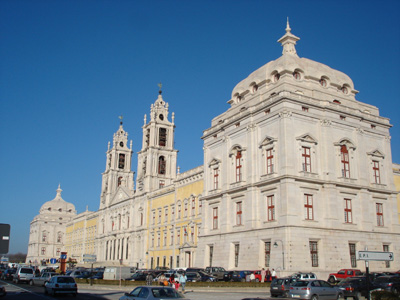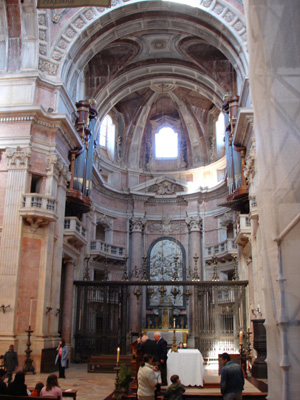 |
||||||||||
 |
||||||||||
|
1190: The Basilica of the Royal Palace, Mafra, Portugal Mystery Worshipper: Pax Britannica. The church: The Basilica of the Royal Palace, Mafra, Portugal. Denomination: Roman Catholic. The building: The grandiose Royal Palace, including a monastery and basilica along with the royal apartments, was built in 1717 to celebrate the birth of a daughter to King João V. The extravagant king wanted the palace and basilica to compete in magnificence and grandeur with Spain's Escorial and St. Peter's in Rome. The church is one of the finest in Europe for its proportions and its superb use of marble (pink, cream, blue-grey and black, mostly from the local quarries). Fifty-eight Italian-made statues, all larger than life, adorn the façade, narthex and chapels. Indeed, with six large pipe organs and a complete carillon in each of the two massive bell towers flanking the portico (totalling 110 bells, all ordered from Flanders), the ensemble screams "regardless of expense." Rarely used in its history either as a palace or a monastery, almost all of the 880 rooms and the extensive park have long been given over to the Portuguese army. Both the royal and monastic apartments are sparsely furnished and open to the public, giving everything a decidely museum feel. The church: The church is used by the town as the principal parish church, though one assumes the clergy are made to live outside in more modest accommodations than the palace apartments. The neighborhood: The distinctly overwhelmed small town abuts all sides of the palace, excepting the park to the rear. On the third Sunday of each month (as on this day) the immediate environs are packed with a local market – stalls selling all manner of cheap clothes, household goods and food. My visit took place the week before Christmas, and business was roaring. A large, life-sized crèche on the sweep of steps up to the portico was the focus of much photograph-taking, as was (with the addition of more devotional activities) the smaller but attractive crèche in a side chapel inside the church. The cast: The cast were not named. A secular celebrant and a religious concelebrant (a Dominican I think) were attended by a dozen laypeople in red tunics, who distributed the holy communion, and ten youngish servers in scruffy cassock-albs. The date & time: Sunday, December 18, 2005, 10.30am, fourth Sunday of Advent. What was the name of the service? Mass. How full was the building? All seats taken – about 400 – but that left a lot of free space. Did anyone welcome you personally? No. There was no one on duty, nor anyone really needed for that, though a woman came round just before the mass and handed out the text of some of the propers on a small photocopied sheet of paper. The exchange of peace was quite enthusiastic, with expectations that all hands round about would be shaken (and ladies kissed – very popular in Portugal). Was your pew comfortable? The wooden pews were adequately proportioned but very hard, with hard kneelers. There is not much kneeling in modern liturgies, and opinion in Portugal seems divided as to whether to kneel or stand for the eucharistic prayer – the standees then make it rather awkward for those of us who like to kneel and yet see what's going on. How would you describe the pre-service atmosphere? Slightly chaotic, with latecomers (the service began five minutes after time) trying to squeeze in. What were the exact opening words of the service? "Em nome do Pai, do Filho e do Espírito Santo, Amén." What books did the congregation use during the service? No books were evident at all – only the photocopied sheet with the propers. Nor did I see anyone with their own missals. What musical instruments were played? One of the organs (the instrument on the south side of the chancel, if you want to know) was played, but only to accompany a distinctly amateur choir. The vocalists, who sang popular folk-type settings of the propers and a motet or anthem during the offertory and communion, were unfortunately overmiked and so mostly drowned out the organ, though some nicely nasal reeds were evident at times. The absence of organ solos might have been attributed to it being Advent. Did anything distract you? I regret that my roving eye kept wandering over the pink marble and the patterns made by the brilliant sunshine pouring in the windows. The nave, unusually so for a baroque church, is devoid of statuary, paintings, or even an inscription around the cornice, and therefore one is free to admire the pure architectural forms of great elegance and subtlety. The early 19th century English novelist William Beckford commented admiringly on the exquisite carving of the pilaster capitals, so I felt in good company. Was the worship stiff-upper-lip, happy clappy, or what? Utterly dreary modern Roman. Almost all traditional ceremonies stripped away, so no incense, and no acolytes with candles. The only thing the servers did was to hold the plates under the mouths of those receiving holy communion. Substituting, perhaps, for these ancient (and still mandated) ceremonies was the faux-liturgical horror of the Advent wreath, placed on a draped stool in front of the inevitable nave altar. At the start of the mass, the fourth wretched candle was lit on the wreath with great ceremony; thus there were more candles honoring this empty symbol (of what, exactly?) than were on the altar itself.  Exactly how long was the sermon? 10 minutes. On a scale of 1-10, how good was the preacher? 6 – The assisting concelebrant preached, and started with what must have been a good joke, as the crowd laughed heartily. A lively delivery, but it seemed to me that we got to hear rather too much of him by the end of the mass. In a nutshell, what was the sermon about? Unfortunately I cannot say, as it was in Portuguese, a language in which this mystery worshipper is not schooled. All I was able to decipher was that toward the end of the sermon he encouraged the congregation to make their confession in preparation for Christmas. Which part of the service was like being in heaven? The sublime magnificence of the building, and the occasional audible toot of the organ, ever so slightly, deliciously, out of tune, above the over-amplified choir. And which part was like being in... er... the other place? The warmth of the December sunshine had failed to penetrate the interior, and it was cooooold! As indeed was the miserably perfunctory way in which the liturgy was celebrated in this glorious place. The expenditure of large quantities of Brazilian gold deserved better. I thought ruefully of the building's opening ceremonies in 1730, when the consecration and pontifical high mass in the presence of King João V and his court lasted from 7.00am to 3.00am the next day (presumably with potty breaks). What happened when you hung around after the service looking lost? The crowd mostly fled to do more shopping at the market, though some stayed to visit the crèche. I was ignored, or left to wander around at will (depending on your point of view). The church closed at lunch time, but generously reopened in the afternoon until dusk for visits, though there was of course no other service that day. How would you describe the after-service coffee? None was available, but excellent coffee and delicious cream tarts can be found at any number of cafes opposite. How would you feel about making this church your regular (where 10 = ecstatic, 0 = terminal)? 3 – The church caters entirely (and quite correctly) for a local congregation, and one would have to speak fluent Portuguese to appreciate its ministry to the fullest. One would also have to be liturgically illiterate, or simply not care – as indeed many do not. There are signs of local musical enthusiasm, so were I to maintain a villa in Mafra I might try to join the choir and get musical standards up (and the obtrusive miking turned down). Did the service make you feel glad to be a Christian? The building, its history, and indeed the fact it was being used for its intended purpose, all made me feel glad. On the other hand, it was sad not to see a greater appreciation of its liturgical possibilities, even in the context of a parish mass. What one thing will you remember about all this in seven days' time? The exquisite color and texture of the acres of pink marble. |
|
|
||||||||||||||||||||||||||||||||||||
| More Mystery Worshipper reports | |||||||||||||||||||||||||||||||||||||||
 |
|||||||||||||||||||||||||||||||||||||||






